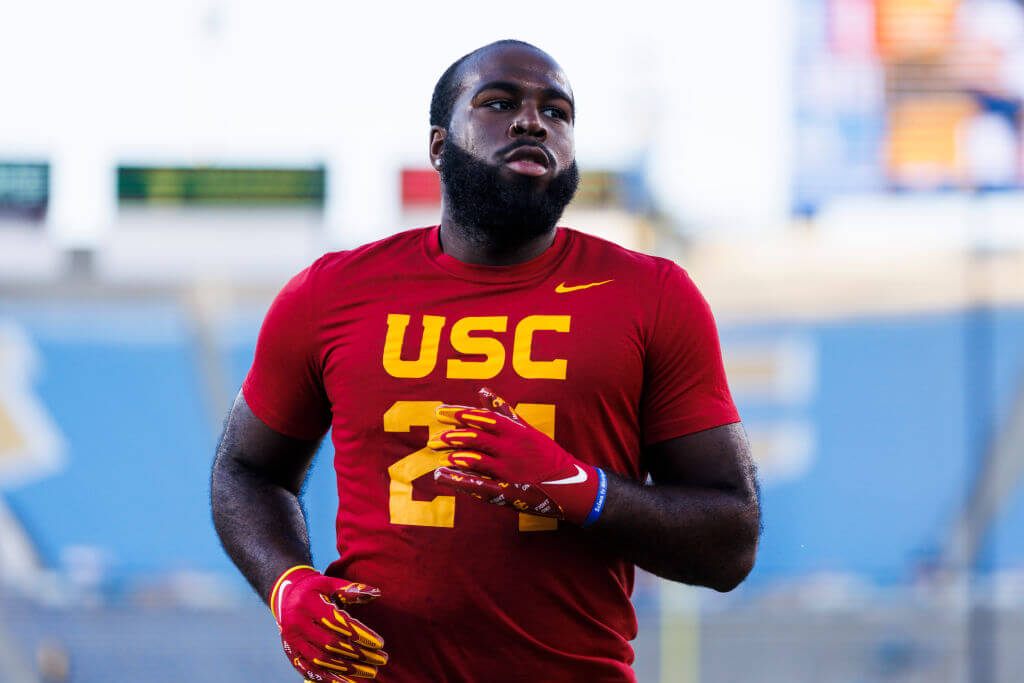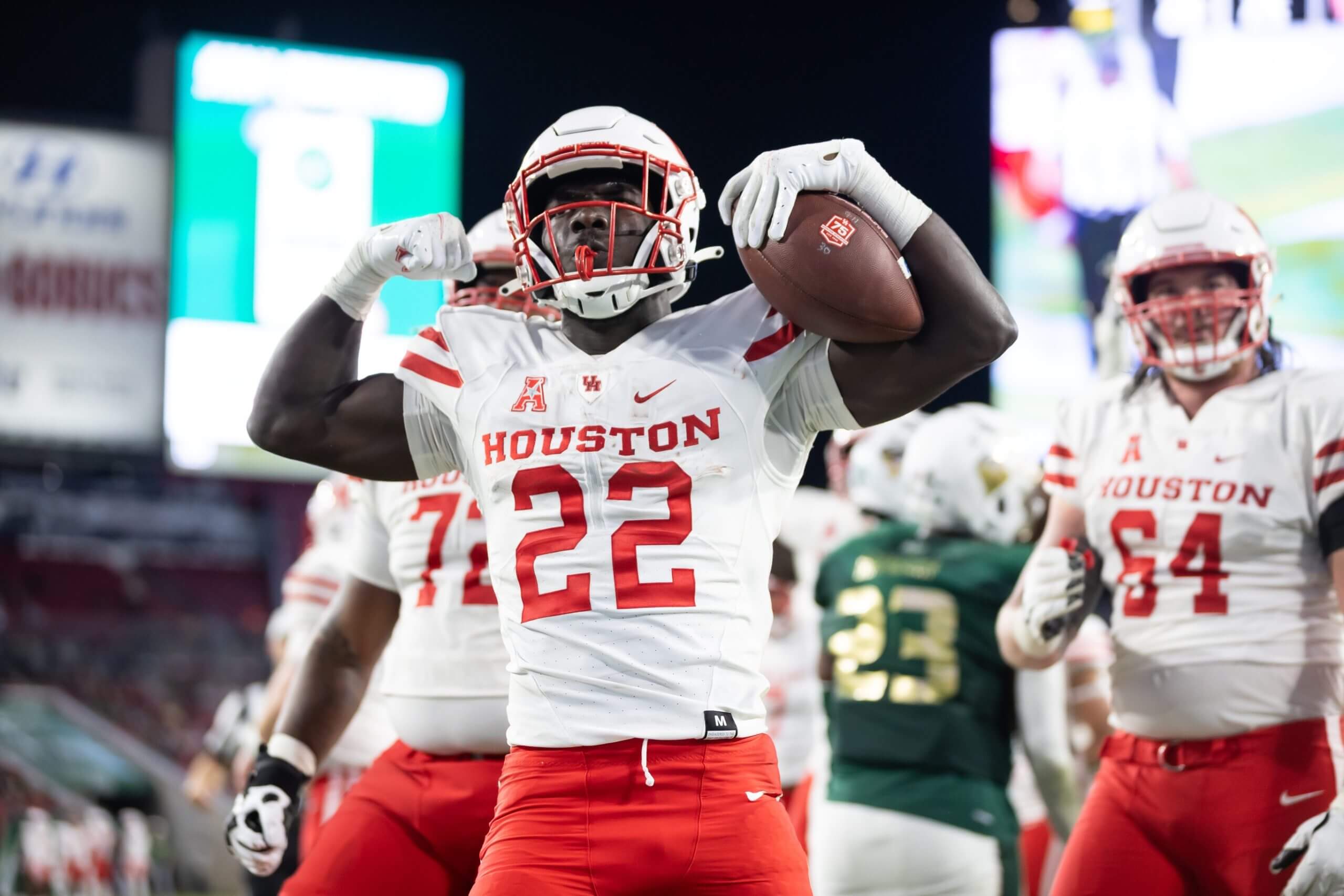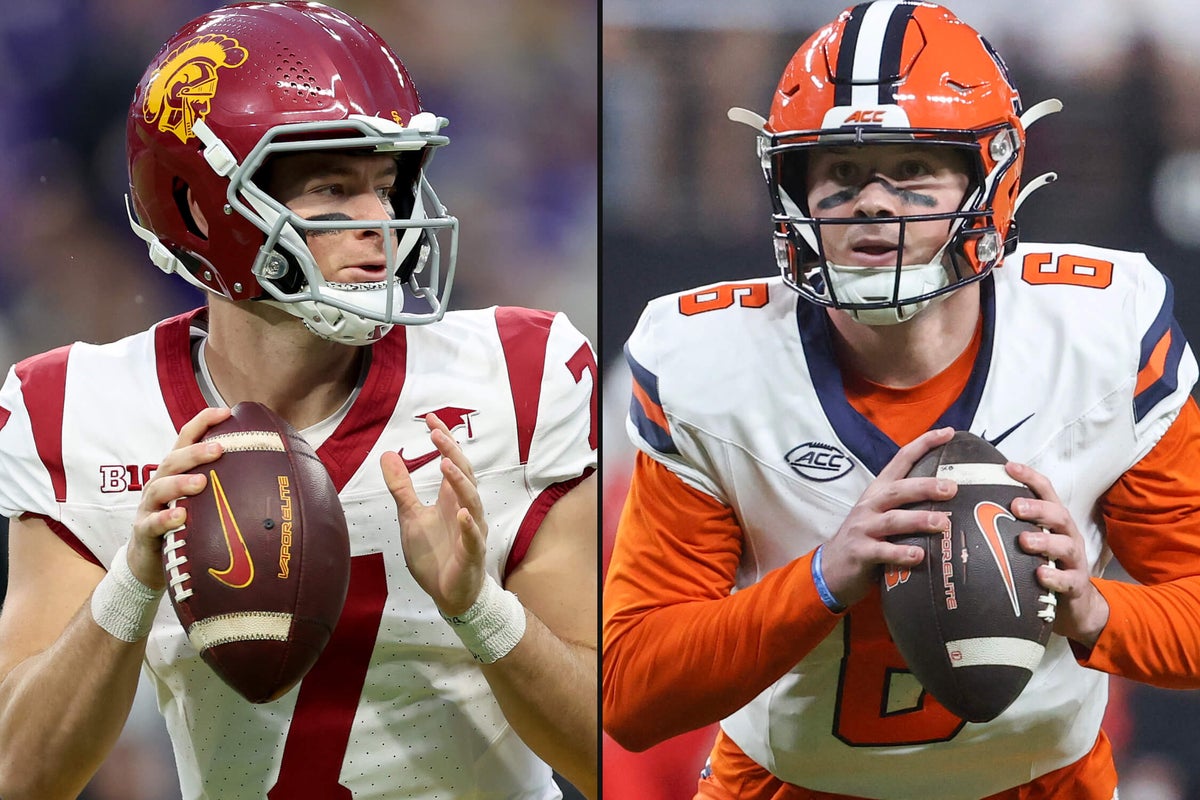With the turnstiles of the NCAA transfer portal spinning, it seems a good time to ask: How many teams do football players join during their college careers?
The Athletic dug into the data, examining the top 50 prospects at every position in the Class of 2021, according to 247Sports. We tallied how many programs the 600 total prospects played for during their careers, including the number of times they transferred.
Some are still playing. Some have moved on to the NFL or away from the sport.
In total, 60.3 percent (362 of 600) of players examined transferred at least once. Of that group, a third (33.4 percent) transferred multiple times.
Players in the Class of 2021 were the first in college football history to begin their careers with the freedom to transfer once with guaranteed, immediate eligibility. Further rule changes gave them the ability to do so multiple times.
The impact of the rule changes goes well beyond the numbers. Some players transfer because they are seeking change after struggling to earn playing time in their first couple seasons. Some players who stand out early in their careers earn a ticket to a bigger program — and a bigger payday — and cash in by transferring.
Injuries can derail careers and leave players adjusting to unexpected circumstances. In some cases, a coach can curtly tell a player: There is no future for you here.
Every transfer portal story is different.
College football has never seen movement like this, but just how much movement is there?
Travelin’ QBs
Quarterbacks transferred with the highest frequency. Of the top 50 prospects in the Class of 2021, 42 changed schools at least once. Eighteen transferred multiple times.
The single-transfer QBs include a few success stories, like Caleb Williams at USC, Quinn Ewers at Texas, Jaxson Dart at Mississippi and Shedeur Sanders at Colorado.
Of the 18 who transferred multiple times, only one (Christian Veilleux at Georgia State) has started at quarterback for an FBS team at his final destination. Two others (Sam Vidlak at Stephen F. Austin, Deacon Hill at Utah Tech) have done so at the FCS level. At least three more — Kaidon Salter at Colorado, Braylon Braxton at Southern Mississippi and Gavin Wimsatt at Jacksonville State — appear poised to start for their teams this season. Eli Stowers also became a starter at Vanderbilt — but after switching positions to tight end when he left Texas A&M for New Mexico State.
For comparison sake, in 2011, 24 quarterbacks in the top 50 (48 percent) transferred. Just one among the top 50 in 2011 transferred twice.
Quarterbacks who won starting jobs at their first school were not lured away by anything other than coaching changes, like Williams, who followed Lincoln Riley from Oklahoma to USC.
Drake Maye stayed at North Carolina and became the No. 3 pick in last year’s draft. J.J. McCarthy won a starting job in Year 2 at Michigan, won a national title and became a top-10 pick. Jalen Milroe rode out Nick Saban’s retirement and was a third-round pick this spring. Behren Morton is leading one of the most well-funded rosters in college football this fall at Texas Tech. Garrett Nussmeier is the center of LSU’s attempted Playoff run this fall. The lone exceptions were Heinrich Haarberg and Jordan Moore, who changed positions at Nebraska and Duke, and Jay Woolfolk, who signed with Virginia but elected to play baseball.
What else we learned
• SportsSource data from the Class of 2011 indicates that the number of transfers has ballooned in the past decade. In a sample of 1,565 three-, four- and five-star prospects from 2011, only 16.2 percent of players transferred from their original schools. It’s not a perfect comparison: SportsSource data is by star rating, and the 2021 data is built off the top 50 at each position regardless of star rating. But the difference between the two numbers is indicative of the shift in the sport.
• At other positions, players who star at big programs and see a clear path to NFL stardom generally aren’t swayed by the portal: Ohio State receiver Emeka Egbuka, Georgia tight end Brock Bowers and Alabama offensive lineman JC Latham are examples of players who stayed at their original schools and became first-round draft picks. Of the top 10 players in the 2021 class regardless of position, only four transferred once, including quarterbacks Ewers and Williams. Defensive lineman Korey Freeman spent three seasons at USC before transferring to Fresno State. And OL Tommy Brockermeyer transferred from Alabama to TCU before medically retiring.
• Predictably, the loosened transfer rules have also paved the way for multiple-time transfers. In the 2011 class, out of those 1,565 three-, four- and five-star prospects, only 11 (0.7 percent) transferred more than once. Five of those 11 were quarterbacks. In the 2021 class, among just the 600 we examined, 121 (20.2 percent) transferred more than once.
• While quarterbacks led the way with 84 percent of prospects transferring, followed closely by wide receivers at 82 percent, offensive and defensive lines were the only positions at which fewer than half of prospects transferred. Just 48 percent of offensive linemen transferred and 44 percent of defensive linemen transferred.
Here’s a closer look at a few of the top 50 players at their position in the Class of 2021 and how the transfer portal worked out for them.

Julien Simon made the best of his first transfer from USC to Tulsa, but called his second transfer one he might regret. (Ric Tapia / Icon Sportswire via Getty Images)Forced into the portal
USC was Julien Simon’s dream school, and he joined the Trojans out of high school as the No. 16 linebacker in the 2021 class. But eight months later, USC fired coach Clay Helton. Simon stuck around for Lincoln Riley’s first season but found himself in a meeting with Riley after the 2022 season, having appeared in five games in two years.
“I already knew I was going into the portal, but it was a kick out the door I was already going out of,” Simon said.
One of the highest-rated prospects in Helton’s final class, Simon headed to Tulsa to join his older brother Jayden, who transferred there from Colorado before the 2022 season.
He thrived under first-year coach Kevin Wilson, winning a starting job and finishing second on the team in tackles. But after the season, his brother elected to leave, and Simon followed in search of a bigger program.
UConn coaches spotted his brother’s film on social media, eventually making an offer.
“My decision to leave Tulsa was probably one that I might regret,” Simon said. “I ultimately ended up at UConn because of my brother’s situation and how he landed there, thinking it would be a good spot for me too.”
But Simon was a sparsely used backup at UConn, making just five tackles and one sack.
Simon re-entered the portal in December but said it’s likely he won’t be on a roster this fall. Kent State was the only program to show interest in him, he said, but didn’t offer him a roster spot. He graduated from UConn in May with a degree in general studies with a minor in urban and community studies. He said he earned a few hundred dollars in NIL deals, all brokered by him.
His advice for himself coming out of high school?
“Listen to your heart and your heart only. That’s the one that matters,” he said. “Let yourself guide you, not anyone else.”
A career revived by the portal
Kyle McCord called his exit from Ohio State after his first season as starter a “business decision.”
The five-star quarterback prospect had waited his turn, and in 2023, threw 24 touchdowns and six interceptions. Two of those picks, though, came in a loss to Michigan with a Big Ten championship game bid and College Football Playoff berth at stake. He topped 3,000 yards passing and was in the top 25 in yards per attempt and completion percentage but hadn’t convinced the Buckeyes he was elite.
The Columbus Dispatch reported that OSU was unwilling to commit to him as the starter in 2024, and McCord entered the portal, landing at Syracuse.
“Going from Year 1 to Year 2 as starter, I was going to make a big improvement. It was a combination of a lot of things,” McCord said.
He had improved his ability to study film. And the game had slowed down for him late in the season. Plus, much of what he’d learned in two seasons behind C.J. Stroud was beginning to set in.
“Looking back on it, that was probably the best thing that could have happened for me as a young quarterback,” McCord said.
McCord’s connections with offensive coordinator Jeff Nixon and quarterbacks coach Nunzio Campanile brought him to Syracuse and coach Fran Brown.
In 2024, he led the nation in passing yards with 4,779. He threw 34 touchdowns and 12 interceptions on a nation-leading 592 attempts, up from 348 in 2023. Syracuse won 10 games for just the second time since 2001. McCord was picked in the sixth round of this spring’s NFL Draft by the Philadelphia Eagles. He was the seventh quarterback picked, four picks ahead of Will Howard — the Kansas State transfer who replaced him at Ohio State.
Of the top 50 quarterback prospects in the Class of 2021, eight have been drafted so far. Others like Garrett Nussmeier, Luke Altmyer, Miller Moss, Sawyer Robertson and Taylen Green could possibly join them next year.

Alton McCaskill has just 21 carries since breaking out as a freshman at Houston. He’s now on his fourth school. (Matt Pendleton / Imagn Images)An injury leads to the portal
Alton McCaskill began the spring of 2022 with limitless promise. The running back was coming off a 1,000-yard, 18-touchdown season as a true freshman at Houston in 2021.
But in April 2022, he tore the ACL in his left knee. His second season in Houston was over five months before it began.
Three years later, he’s on his fourth school and has carried the ball 21 times since that breakout season. He’s preparing to reboot his career at Sam Houston State under new coach Phil Longo.
“It’s been a ride,” McCaskill said. “It never goes quite like you expect it.”
A year after his injury, McCaskill shocked Houston by leaving for Colorado and joining Deion Sanders’ program ahead of Sanders’ first season. That offseason, he was even featured in a California Almonds commercial alongside Sanders that aired nationally throughout the fall.
“Coach Prime just went in there and turned his movie star on. It was crazy. He aced it,” McCaskill said. “That was the first time I’d done anything to that magnitude, and it was really cool.”
That fall, he played sparingly, and in October, he went to Sanders and said he wanted to redshirt and intended to continue strengthening his knee.
But after working with the Buffaloes the following spring, McCaskill elected to re-enter the transfer portal and signed with Arizona State.
“I just didn’t think they were going to run the ball a lot,” McCaskill said of Colorado.
After seven carries for 17 yards in the Sun Devils’ opener, McCaskill didn’t record a statistic the rest of the season. After this spring, he didn’t like his place in a crowded group of running backs that added Kanye Udoh from Army to help replace Cam Skattebo. He sought a program where playing time would be more likely.
“Everybody’s situation is different. People might think this or that, but they aren’t having the conversations with people in a facility every day and get the same vibes,” he said. “If somebody does something you don’t like at work, you might think about not going into that job anymore. It’s the same exact thing.”
Stuck in the portal
Christian Pedersen wanted to sign with the biggest and best program that would have him. As the nation’s No. 43 tight end, that meant Louisville. His senior high school season had been canceled during the COVID-19 pandemic, and he felt out of his depth in college.
“I was on the scout team and had to block Yaya Diaby. He’s with the Bucs now. And I was like, ‘How am I gonna do this?’” Pedersen said.
After Pedersen redshirted his freshman season, the coaching staff told him he likely wouldn’t be a major contributor until his junior or senior seasons. He elected to transfer, but didn’t enter the portal until July. His options during the dead period were minimal, and he found himself stuck in the portal during the 2022 season.
He moved closer to his family, which had relocated to Nashville from California, and spent the fall training on his own and working a construction job in stone care.
“Not fun, and while it kind of sucked, it was the perfect thing I needed for me mentally and physically,” he said. “I had to re-evaluate myself and be sure this was what I wanted.”
That December, he landed at Florida International. There, he could compete. His confidence returned, though he played sparingly.
After the 2023 season, he was nervous for his exit meeting with his coaches, but it went better than expected. Two weeks after the portal opened, though, he got a call from his position coach, who said they were going in another direction at tight end.
In the days that followed over the Christmas holiday, coaches consistently checked to see if he’d filed to enter the transfer portal.
“I was devastated,” he said. “It rocked my world. I didn’t even know if I wanted to play football anymore after that. I didn’t know what to do for college.”
He had just signed a lease for an apartment in Miami and needed help finding a subletter.
Pedersen said he never earned any money in his career from NIL.
A friend at Louisville had joined Morehead State’s staff as a graduate assistant and told Pedersen the FCS program in Kentucky would likely have a spot for him.
“I took a visit and was like, ‘You know what, why not?’” Pedersen said.
He finished fourth on the team with nine catches for 91 yards last year. He scored his first career touchdown.
He’s planning on playing a fifth season this fall and is on track to get a degree in communications in December.
“Call it what you will. You’re getting fired. It’s harsh. But I’m grateful to have experienced it,” Pedersen said of his two trips into the portal. “I feel like I’ve got an edge in the business world because I know what failure is.”
(Top photos of quarterbacks Miller Moss and Kyle McCord: Steph Chambers, Ian Maule / Getty Images)

